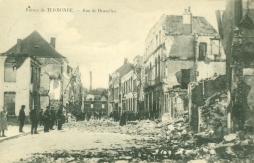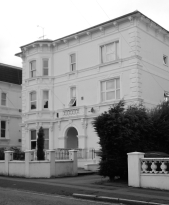Today I have (almost) become an expert on orchids – ok, let’s just say I certainly know a lot more about them than I did this morning!
A couple of years ago I exchanged emails with the great-granddaughter of Jules Jacques DE COENE, a Belgian who was an orchid grower at the Stuart Low Orchid Nursery in Jarvis Brook from around 1912. I filed our exchange away for future consideration as Mr De Coene wasn’t a wartime refugee and wasn’t connected with Tunbridge Wells.
Lately I’ve been looking at Belgians in Crowborough and thought I’d take another look.
Well, first of all let me say that I had no idea Jarvis Brook was home to such a prestigious and world-renowned orchid nursery for so many years [1] – or that I lived so close to its former site! Or for that matter that Belgium had produced such stars in the orchid-growing firmament!
The Orchid Review monthly magazine of July 1914 devoted several pages to the nursery – you can read the complete article here – but in summary, it moved from Bush Hill Park, Enfield, Essex, to Brookhurst, Walshes Road, Crowborough, around 1910 [2], driven away by the deterioration of the orchid-growing environment caused by an increase in building and, it seems, fog. I found this advertisement in the Sussex Agricultural Express of 15th July 1910. Could that be when Stuart Low moved his nurseries?

In Jarvis Brook, Stuart Low’s nursery found a sheltered position “in the Sussex heights” some “500 ft above sea level”, enjoying clear air and sunshine, and protection from the wind. Twenty-five glasshouses in two blocks were erected, and the orchids thrived in their new home. [3]
“One by one the old Orchid firms are disappearing from the metropolitan area, being driven by the exigencies of space, or the prevalence of fog and the absence of sun during the winter months, to seek fresh fields and pastures new for the culture of their plants.” The Orchid Review, July 1914
In charge of cultivation in 1914 was Gent-born Edward (Edwin?) TACK – “the greatest authority on cattleya orchids in the world” according to his obituary – who had arrived in Britain around 1894 and came to Crowborough in 1908. He died at his home in Jarvis Brook – Ingleside on Western or possibly Walshes Road – in October 1930 after a long illness, and his funeral was well-covered in the local press [4]. Sadly Edward/Edwin had lost his only son, also Edward, in 1915 at the age of just 11. The boy was a member of the 1st Crowborough Scout Troop and on the outbreak of war had been among a group who had gone to Newhaven to act as despatch carriers along the coast – though I don’t think that had any direct bearing on his untimely death. Scouts from Crowborough, St Johns, and Withyham made up a guard of honour for his coffin which was draped with the Union flag (Kent & Sussex Courier, 12 March 1915).
Six years later, in November 1936, the daughter of Jules DE COENE married at All Saints Church in Crowborough and one of Edward TACK’s daughters was her bridesmaid. The DE COENE family had arrived in Jarvis Brook from Essex about the same time as the TACK family – also from the Essex orchid nursery, and Jules DE COENE was eventually to be in charge of the Jarvis Brook nursery according to his obituary in 1943 (Kent & Sussex Courier, 19 March 1943). The family moved into Ingleside at some point, and were still living there in 1939 (next door to the Plough and Horses public house (now flats)).

Also employed at the Nursery was another Belgian, George VERBOONEN, who had possibly come to England amongst the refugees when war broke out, as he was at the time visiting Europe from Brazil according to an article on the Brazilian Orchids website (http://www.delfinadearaujo.com/page2.htm) about the history of the Etablissement P.M. Binot, later the Orquidario Binot, in Brazil [5] – though in the 1911 England Census he is already living at Orchid Cottage, Western Road, Crowborough, and so presumably already working for Stuart Low. And he had witnessed Jules DE COENE’s marriage in New Cross two years earlier in 1909 (coincidentally in the same church as my great-grandparents’ wedding in 1891!).
Unfortunately I didn’t revisit any of this information before going to the Belgian Archives the other week or I could have looked him up. Next time…
I do wonder whether any Belgian refugees were employed there, or indeed whether the DE COENE, TACK and VERBOONEN families were involved in helping their compatriots in the town. Young Edward TACK was a pupil at King Charles the Martyr Boys School in Tunbridge Wells and I know that the school took in one or two Belgian children (see blogpost What about the Belgian children’s education?).
The Memories of Crowborough/Rotherfield Facebook Group alerted me to the fact that during the Second World War, on 26th September 1940, the Nursery was bombed, with two civilian casualties. Presumably the nearby railway line was the target? Or maybe the pilot was simply jettisoning his bombs before returning home. The casualties were 14-year-old nursery assistant Reginald William PAIGE, and nursery Manager Ernest RADFORD who had only been in the post for a year or even less. His home, the aforementioned Orchid Cottage, took a direct hit (Kent & Sussex Courier, 4th October 1940) – his wife survived, suffering ‘only’ from shock. The Courier reported that in all sixteen bombs fell in the area – a local pub lost roof tiles (the Plough and Horses?) and windows were broken in a nearby Chapel as worshippers were leaving after a thanksgiving service.
I was about to make a crass comparison. Instead I will simply mention that this land may well be about to disappear under a housing development – plans are in for 163 homes to be built on the site of Orchid Riding Centre.
Let’s hope the Stuart Low Orchid Nursery is at the very least remembered in the road names…
[1] There are even orchids named after Crowborough – here’s one https://www.orchids.org/grexes/laeliocattleya-crowborough …and Jarvis Brook too… https://www.orchids.org/grexes/cyrtocidium-jarvis-brook
[2] I haven’t yet found the precise date – Edward TACK apparently came to Jarvis Brook in 1908 according to his obituary in the Kent & Sussex Courier, 24th October 1930). I also don’t know when the Nursery closed, but it was still there in 1965. Bernard Lorimer JORDAN had been Manager of Brookhurst Nurseries and was there in the 1911 Census. Was he Manager of Stuart Low’s? He moved on to Rockington Nurseries, Blackness Road – Jordan’s Nursery – now also closed and earmarked for development.
[3] The 1914 article also has this to say about the Nursery’s location, and travelling there – those familiar with the current Uckfield Line may (or may not) appreciate its sentiments (and if you’re following the directions, don’t forget to stop off at The Wheatsheaf on the way…) : “The journey from London is through some of the most lovely scenery in Surrey and Sussex, and is, in fact, quite a holiday jaunt, whether taken by rail or motor. The London, Brighton, and South-Coast Railway have now started a direct and accelerated service, and most trains avoid the change at Groombridge. The Nurseries are some ten minutes walk from Crowborough Station, on the side of a gentle slope, and are about eleven acres in extent.”
[4] Edward TACK’s obituary in the Kent & Sussex Courier also mentions that he had worked on the estate of Baron Alphonse de Rothschild in France before coming to England. A casual google reveals that the de Rothschilds were orchid fanatics.
[5] The Orquidario (Etablissement P.M. Binot) was set up by Pedro BINOT in 1870 and initially imported orchids from Brazil to Belgium. According to this online article, George VERBOONEN was Pedro Binot’s stepson and became director following the death of his step-father in 1911 – perhaps after the Census on 2 April 1911???
Stuart Low’s Jarvis Brook Orchid Nursery in 1956





